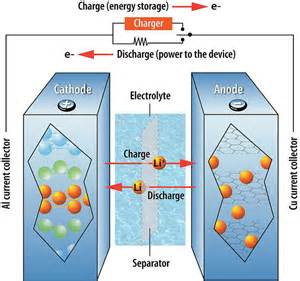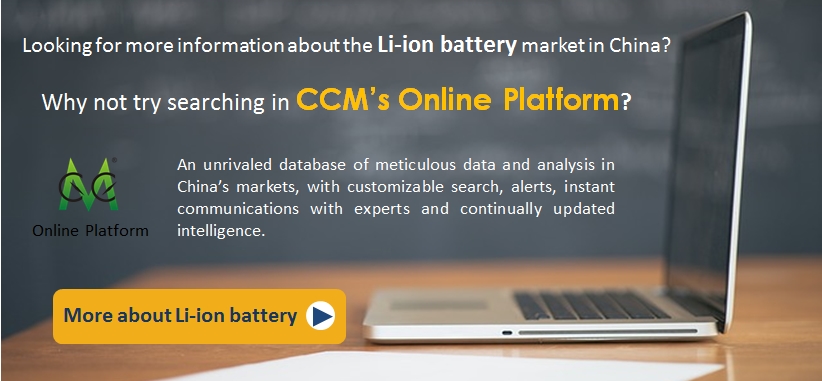In March 2016, data from NBS showed that
China's total output of Li-ion battery in 2015 increased by 3.13% YoY, indicating
a slowdown in the output growth rate. However, many industry insiders believed
that it was not the growth rate of output but the growth rate of battery
capacity that could reflect the real situation of Li-ion battery industry.

Source: Bing
On 3 March 2016, data from the National
Bureau of Statistics of the People’s Republic of China (NBS) showed that only
5.6 billion Li-ion batteries were produced in China last year, up by 3.13% YoY
over 5.43 billion in 2014. Obviously, the increase of Li-ion battery output has
slowed down, comparing with the 10% annual growth rate in previous years.
However, many industry insiders believed that it was not the growth rate of
output but the growth rate of battery capacity that could reflect the real
situation of Li-ion battery industry. This is true, because most domestic power
Li-ion batteries (for alternative energy vehicles) are large-capacity soft
Li-ion battery cells packs. Actually, China’s Li-ion battery market structure
is changing smoothly.
In 2010-2012, the domestic output of Li-ion
batteries increased sharply from 2.51 billion to 4.18 billion, thanks to the
rapid increase of consumer electronics, such as mobile phones and laptops. The
YoY growth rate in 2012 even reached 36.16%. However, the growth has slowed
down since 2013.
In 2014, the output of Li-ion battery exceeded 5 billion pieces for the first
time, but the growth rate dropped significantly in 2015, and even down to
negative growth rate, leading to an annual growth rate of only 3.13%, a record
low since the industrialization of the industry.
Output and YoY growth rate of Li-ion
battery in China, 2010–2015

Source: National Bureau of Statistics of
the People’s Republic of China

Significant changes in application
- Consumer electronics:
The overall annual output of consumer
electronics increased steadily, but some products witnessed a YoY decline. This
led to record weak demand for Li-ion battery. The domestic output of some
electronics in 2015 was as follows:
Mobile phones: 1.82 billion, up by 3.9%
YoY;
Notebook computers (including tablet PC):
175 million, down by 16.8% YoY;
Digital cameras: 19.23 million, down by
20.4% YoY.
- Alternative energy vehicle:
Chinese Li-ion battery industry has been
driven by the alternative energy vehicle industry, which began to develop
rapidly since 2014. The domestic output of alternative energy vehicles was
increasing rapidly, thanks to the promotion by the national and local
governments. In 2015, the domestic output of alternative energy vehicles was
379,000, an increase of 400% YoY.
The changes of consumption pattern helped increase the market share of power
Li-ion battery in domestic Li-ion battery market. In 2014-2015, the market
share of power Li-ion battery has soared from 13% to 52%, exceeding that of
consumer Li-ion battery, whose market share has dropped from 83% to 46%.
- Energy storage:
The domestic market share of energy storage Li-ion battery has dropped from 4%
in 2014 to 2% in 2015, because of the rapid growth of power Li-ion battery,
although more energy storage Li-ion batteries will be applied in mobile
communication and the construction of energy storage station has speeded up.
Changes of market structure led to
polarization in regional industrial distribution.
The top 3 production areas of traditional Li-ion battery in China are the Pearl
River Delta Region (including Guangdong and Fujian provinces), the Yangtze
River Delta Region (including Shanghai, Jiangsu and Zhejiang) as well as the
Beijing-Tianjin-Hebei Region (including Beijing, Tianjin, Hebei).
The former further strengthen its leading position, while the positions of the
latter two are declining, due to the transformation and upgrades of consumer
electronic products, the rapid development of alternative energy vehicle
market, the industrial transfer etc.
The output of Li-ion battery in this 3 production areas in 2015 were as
follows:
Pearl River Delta Region: increased by 20%
YoY to 3.04 billion pieces, accounting for 54.3% of the national total. Amongst
them, 2.36 billion pieces were from Guangdong Province, accounting for 42.1% of
the national total
Yangtze River Delta Region: dropped by 5.2%
YoY to 1.09 billion pieces, accounting for 19.5% of the national total. This
was mainly due to environmental constraints
Beijing-Tianjin-Hebei Region: dropped by
20% YoY to 440 million pieces, accounting for 7.9% of the national total. This
was mainly due to the acceleration of industrial transfer in the region
But it is worth noting that, driven by the booming alternative energy vehicle
industry, the domestic Li-ion battery industry has been developing rapidly in
some provinces and cities. For example, in 2012-2015, the output of Li-ion
battery in Anhui and Shandong provinces has increased from 35 million pieces to
126 million pieces, with an average annual growth rate of 53%.
Besides, the Central and Western Region (including Jiangxi, Hubei, Hunan,
Guizhou, Yunnan provinces and Chongqing Municipality) has made full use of cost
advantage to take Li-ion battery industry transferring from other areas. In
2015, the output of Li-ion battery in this region was 750 million pieces,
accounting for 13.4% of the national total.
In 2016, China's Li-ion battery market
structure is expected to change further.
- Demand:
The market share of consumer Li-ion battery
will continue to decline while that of Li-ion battery will continue to
increase. This is because the consumer electronics market is nearly saturated
The alternative energy vehicle market will
maintain the momentum of rapid growth, pushing by the target of consuming 5
million alternative energy vehicles by 2020
The demand for energy storage Li-ion
battery will continue to increase, since PV installed capacity is increasing
rapidly and the application of Li-ion battery in communication field is also
accelerating
- Regional distribution:
Anhui Province, Shandong Province and the
Central and Western Region will continue the momentum of rapid growth
The Pearl River Delta Region won’t witness significant
growth rate, as the current output is already very huge
The Yangtze River Delta Region and the
Beijing-Tianjin-Hebei Region will inevitably continue the downward trend
* This article comes from China Li-ion Battery News 1603, CCM

About CCM:
CCM is the leading market intelligence
provider for China’s agriculture, chemicals, food & ingredients and life
science markets. Founded in 2001, CCM offers a range of data and content
solutions, from price and trade data to industry newsletters and customized
market research reports. Our clients include Monsanto, DuPont, Shell, Bayer,
and Syngenta. CCM is a brand of Kcomber Inc.
For more information about CCM, please
visit www.cnchemicals.com or get in touch with us directly by emailing
econtact@cnchemicals.com or calling +86-20-37616606.
Tag: Li-ion battery , alternative energy vehicles